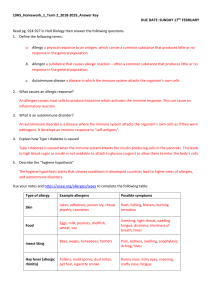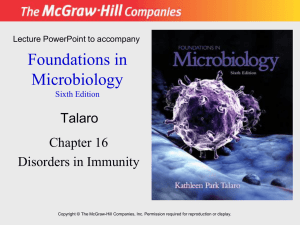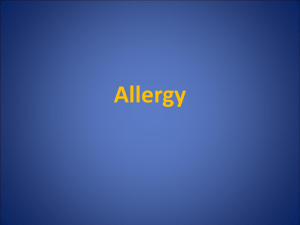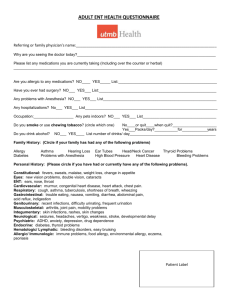Preface
advertisement
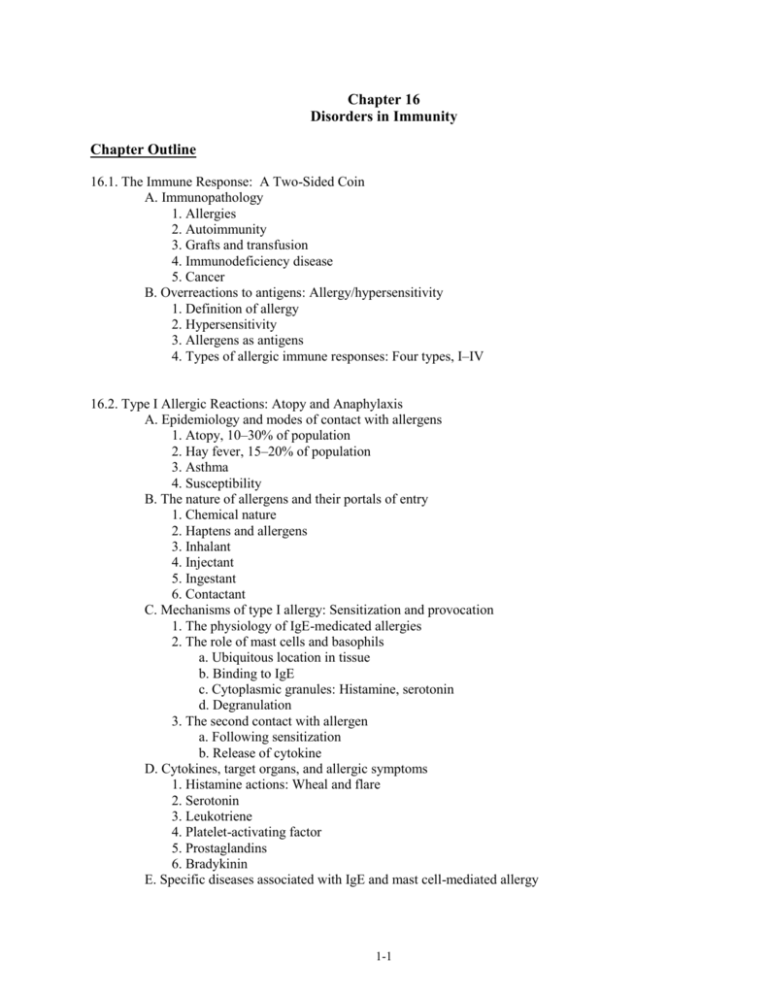
Chapter 16 Disorders in Immunity Chapter Outline 16.1. The Immune Response: A Two-Sided Coin A. Immunopathology 1. Allergies 2. Autoimmunity 3. Grafts and transfusion 4. Immunodeficiency disease 5. Cancer B. Overreactions to antigens: Allergy/hypersensitivity 1. Definition of allergy 2. Hypersensitivity 3. Allergens as antigens 4. Types of allergic immune responses: Four types, I–IV 16.2. Type I Allergic Reactions: Atopy and Anaphylaxis A. Epidemiology and modes of contact with allergens 1. Atopy, 10–30% of population 2. Hay fever, 15–20% of population 3. Asthma 4. Susceptibility B. The nature of allergens and their portals of entry 1. Chemical nature 2. Haptens and allergens 3. Inhalant 4. Injectant 5. Ingestant 6. Contactant C. Mechanisms of type I allergy: Sensitization and provocation 1. The physiology of IgE-medicated allergies 2. The role of mast cells and basophils a. Ubiquitous location in tissue b. Binding to IgE c. Cytoplasmic granules: Histamine, serotonin d. Degranulation 3. The second contact with allergen a. Following sensitization b. Release of cytokine D. Cytokines, target organs, and allergic symptoms 1. Histamine actions: Wheal and flare 2. Serotonin 3. Leukotriene 4. Platelet-activating factor 5. Prostaglandins 6. Bradykinin E. Specific diseases associated with IgE and mast cell-mediated allergy 1-1 1. Atopic diseases a. Hay fever or allergic rhinitis b. Asthma c. Atopic dermatitis (eczema) 2. Food allergy 3. Drug allergy F. Anaphylaxis: An overpowering systemic reaction 1. Cutaneous 2. Systemic and shock G. Diagnosis of allergy 1. Histamine release test (in vitro) 2. Skin testing (in vivo) H. Treatment and prevention of allergy 1. Three rationales a. Avoid allergen b. Treat with medication c. Desensitization 2. Therapy to counteract allergies a. Antihistamines b. Desensitization or hyposensitization 16.3. Type II Hypersensitivities: Reactions That Lyse Foreign Cells A. Human blood types B. The basis of human ABO isoantigens and blood types C. Antibodies against A and B antigens 1. Clinical concerns in transfusions a. Universal donor and universal recipient b. Other RBC markers: Rh, Kell, and MN c. Transfusion reactions D. The Rh factor and its clinical importance 1. Hemolytic disease of the newborn and Rh incompatibility: Erythroblastosis fetalis 2. Preventing hemolytic disease of the newborn E. Other RBC antigens 16.4. Type III Hypersensitivities: Immune Complex Reactions A. Mechanisms of immune complex disease B. Types of immune complex disease 1. The arthus reaction 2. Serum sickness 16.5. Type IV Hypersensitivities: Cell-Mediated (Delayed) Reactions A. Delayed-type hypersensitivity 1. Infectious allergy a. Mycobacterium tuberculosis b. Tuberculin reaction B. Contact dermatitis C. T cells and their role in organ transplantation 1. The genetic and biochemical basis for graft rejection 2. T-cell-mediated recognition of foreign MHC receptors a. Host rejection of graft b. Graft rejection of host i. Graft versus host disease c. Classes of grafts i. Autograft 1-2 ii. Isograft iii. Allograft iv. Xenograft d. Avoiding and controlling graft incompatibility i. Tissue matching: Mixed lymphocyte reaction ii. Tissue typing: HLA e. Types of transplants 16.6. An Inappropriate Response Against Self, or Autoimmunity A. Genetic and geder correlation in autoimmune disease 1. Rheumatoid arthritis 2. Ankylosing spondylitis 3. Systemic lupus erythematosus 4. Graves’ disease 5. Myasthenia gravis B. The origins of autoimmune disease 1. Sequestered antigen theory 2. Clonal selection theory 3. Theory of immune deficiency 4. Inappropriate expression of MHC II markers on cells 5. Molecular mimicry 6. Autoimmune regulator protein C. Examples of autoimmune disease 1. Systemic autoimmunities a. SLE and rheumatoid arthritis 2. Autoimmunities of the endocrine glands a. Graves’ disease b. Hashimoto’s thyroiditis c. Diabetes mellitus 3. Neuromuscular autoimmunities a. Myasthenia gravis b. Multiple sclerosis (refer to current viral theories) 16.7. Immunodeficiency Diseases: Hyposensitivity of the Immune System A. Primary immunodeficiency diseases 1. Clinical deficiencies in B-cell development or expression a. Agammaglobinemia b. Hypogammaglobinemia c. IgA deficiency 2. Clinical deficiencies in T-cell development or expression a. Abnormal development of the thymus: DiGeorge syndrome 3. Severe combined immunodeficiencies: Dysfunction in B and T Cells a. Swiss-type agammaglobinemia b. Thymic alymphoplasia c. Adenosine deaminase deficiency d. Bare lymphocyte syndrome B. Secondary immunodeficiency diseases 1. Causes a. Infection—HIV/AIDS b. Organic disease c. Chemotherapy 1-3
